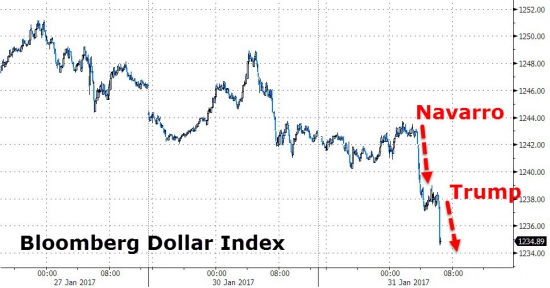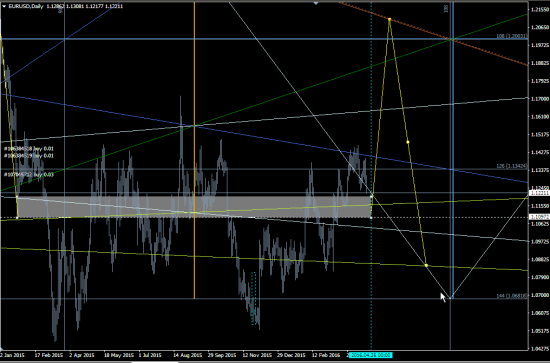FEd
Центральные банки продвигают отказ от наличных денег
- 01 мая 2017, 15:29
- |
Центральные банки США и Канады продвигают планы по внедрению цифровой формы денег центрального банка. К этим планам относится также «Project Jasper» канадского ЦБ, при совместной работе с Payments Canada и финансово- технической фирмы R3. Цель проекта в том, чтобы найти возможность осуществлять крупные платежи независимо от банковских счетов.
www.finextra.com/finextra-downloads/newsdocs/cad-coin-versus.pdf
В настоящее время проводятся симуляции платежей многих участников, для этого ЦБ канады выпустило определенную сумму в цифровой валюте «CAD-Coin»
Платежи осуществляются в частной сети допущенных к эксперименту банков. Банки могут использовать эту валюту для платежей между собой, или же переслать в ЦБ и обменять на канадские доллары. Пока точно неизвестно, является ли CAD-Coin настоящей цифровой валютой, или же вариацией денег ЦБ.
Также и в США Federal Reserve Bank of St. Louis работает над цифровой валютой, которую можно использовать для частных ежедневных платежей, под названием «Fedcoin». Эта валюта работает также как и Биткойн, но обменный курс к доллару составляет 1 к 1.
( Читать дальше )
- комментировать
- ★1
- Комментарии ( 9 )
Члены Комитета FOMC одобрили идею о начале сокращения баланса ФРС и анонсировали распродажу активов на 4,5 трлн долларов
- 06 апреля 2017, 17:03
- |
Согласно сегодняшней публикации CNBC, большинство голосующих членов Комитета, принимавших участие в заседании американского центрального банка, согласились с тем, что баланс ФРС необходимо сокращать, правда, каким именно образом это будет осуществляться и какими темпами – пока неясно, однако процесс обдумывания запущен. Мы должны отнестись к этому сообщению самым серьёзным образом, поскольку в пользу неизбежности «стерилизации» баланса Федрезерва говорят несколько факторов, о которых речь пойдёт ниже.
На сегодняшний день на балансе ФРС находится активов приблизительно на 4,5 трлн долларов. В основном, это – казначейские облигации средней и длинной дюраций, а также – «агентские» бумаги (облигации американских ипотечных дилеров Fannie Mae и Freddie Mac). Как известно, американский центробанк активно скупал данные ценные бумаги для стимулирования экономики и снижения стоимости заимствования. Власти Соединенных Штатов запускали программу количественного смягчения трижды. Программа QE1 была запущена в 2008 г., QE2 – в 2010 г. и, наконец, QE3 –в 2012 г. В конце 2014 г. было принято решение плавно завершить последнюю программу.
( Читать дальше )
ECB аккуратно расширил лимиты по баксам...))
- 03 апреля 2017, 20:18
- |
Так вот ЕЦБ, спустя 2 нед от события продолжил расширять лимиты на баксовое mro-фондирование. Одно время (кто помнит панические «евро идет на 1,5» ) в узких кругах)) была популярна идея, что этот фондирующий канал колатеролайзится в свою очередь поддерживается свопами ецб-фрс и, соответственно, его лимиты использовались как индикатор лимитов (в этих свопах ФЕДа на ЕЦБ) — соответственно сворачивания или ))наоборот расширения баксофондирования ФЕДом Евросистемы
под повышение FFR вместо традиционных 200 лямов в евросистеме выбирают теперь, вувля:
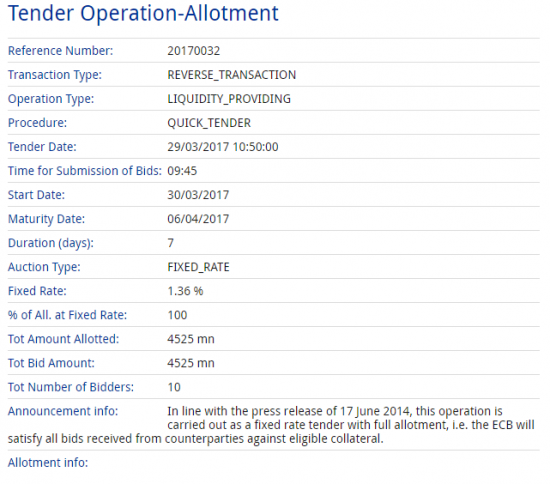
последний раз ЕЦБ давал в сопоставимых масштабах только в конце октября — кто помнит это отразилось и на местном рынке http://smart-lab.ru/blog/353904.php когда закрывали мгновенные потребности db, ucg, и, возможно, райфА.
( Читать дальше )
ZeroHedge: Доллар падает после того, как Трамп обвинил другие страны в "Девальвации"
- 31 января 2017, 17:40
- |
Оказывается в Америке «политика сильного доллара» закончилась...
- TRUMP: OTHER COUNTRIES TAKE ADVANTAGE BY DEVALUATION
Вычёркивает весь рост на заявлениях ЕЦБ и Феда.
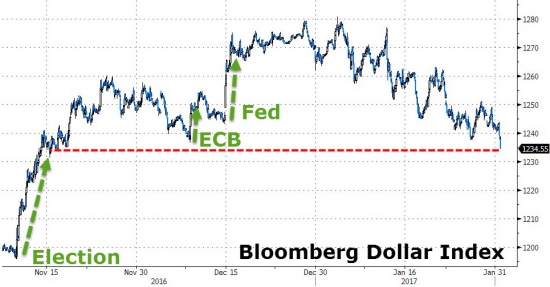
( Читать дальше )
Заседания ФРС США (FOMC) на 2017 год в астрологическом отображении.
- 08 января 2017, 18:12
- |
Таким образом, табличка заседаний и протоколов на 2017 год — не является лишней никогда. А если эти даты обрамляются астрологическим контекстом (только выборочные, яркие фрагменты — комментирую не для всех, а по отдельному платному запросу), то жить становиться практичнее, жить становится веселее. Берите на заметку.
Решение по процентной ставке ФРС США 31 января-1 февраля 2017 года

Публикация протоколов заседания ФРС США 22 февраля 2017 года
( Читать дальше )
Ставка ФРС (реакция фьючерса на ставку, появление вероятности снижения ставки)
- 24 июня 2016, 18:14
- |
Опять что-то помешало нормализации от ФРС. Как говорится плохому танцору...
По оценке фьючерса на ставку ФРС
никакого повышения ставки в июле, в сентябре, в ноябре и возможно только в декабре с вероятностью в 23%
Однако!
… вот что интересно — это появление нового столбика на диаграмме!
Появилась вероятность шага назад, то есть снижения таргета ставки федеральных фондов на 25 базисных пунктов.
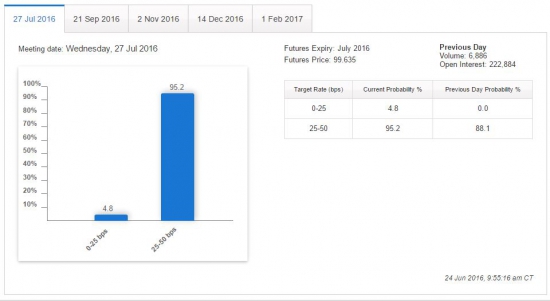
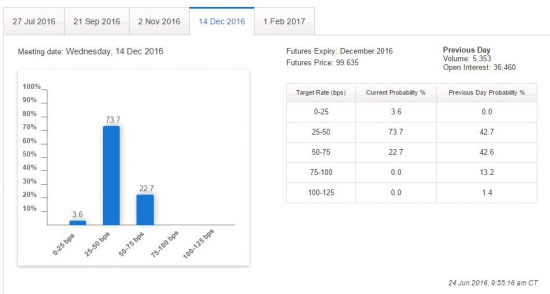
Мировые рынки в шоке после оглашения итогов референдума в Великобритании
- 24 июня 2016, 11:54
- |

Финансовые рынки и наблюдатели по всему миру пребывают в состоянии полного шока после оглашения неожиданных итогов референдума по вопросу членства Великобритании в ЕС, на котором британцы проголосовали за выход страны из блока. Непосредственно перед началом голосования участники рынков полностью полагались на прогнозы букмекеров, предполагающие сохранение страны в ЕС, и готовились именно к этому. Инвесторы зря игнорировали результаты опросов, которые раз за разом указывали на то, что исход голосования не ясен, в результате возможность выхода Великобритании из ЕС была сильно недооценена на финансовых рынках. Не совершайте ошибку, примерно в это же время в прошлом году рынки были в полном смятении касаемо того, какие последствия выход Греции из ЕС может иметь для мировых рынков и подтверждение выхода Великобритании из блока несет собой намного более серьезные риски.
( Читать дальше )
FED Chair's speech right now
- 06 июня 2016, 19:33
- |
At The World Affairs Council of Philadelphia, Philadelphia, Pennsylvania
June 6, 2016
Current Conditions and the Outlook for the U.S. Economy
I am delighted to be with you today. I will discuss recent economic developments, the outlook, and their implications for monetary policy. My message will be largely favorable, although recent developments have been mixed. Most importantly, the economy has registered considerable progress over the past several years toward the Federal Reserve's goals of maximum employment and price stability, and, as I will explain, there are good reasons to expect that we will advance further toward those goals. The news from the labor market over the past year has been generally good, with significant job gains, the unemployment rate declining below 5 percent, rising household incomes, and tentative signs of faster wage growth. At the same time, recent signs of a slowdown in job creation bear close watching. Inflation has been lower than our objective of 2 percent, but I expect it to move up over time for reasons that I will describe. If incoming data are consistent with labor market conditions strengthening and inflation making progress toward our 2 percent objective, as I expect, further gradual increases in the federal funds rate are likely to be appropriate and most conducive to meeting and maintaining those objectives. However, I will emphasize that monetary policy is not on a preset course and significant shifts in the outlook for the economy would necessitate corresponding shifts in the appropriate path of policy.
In particular, an important theme of my remarks today will be the inevitable uncertainty surrounding the outlook for the economy. Unfortunately, all economic projections are certain to turn out to be inaccurate in some respects, and possibly significantly so. Will the economic situation in Europe or China take a turn for the worse or exceed expectations? Will U.S. productivity growth pick up and allow stronger growth of gross domestic product (GDP) and incomes or instead continue to stagnate? What will happen with the price of oil? The uncertainties are sizable, and progress toward our goals and, by implication, the appropriate stance of monetary policy will depend on how these uncertainties evolve. Indeed, the policy path that my colleagues and I judge most likely to achieve and maintain maximum employment and price stability has evolved and will continue to evolve in response to developments that alter our economic outlook and the associated risks to that outlook.
( Читать дальше )
Про Нефть, ФРС и Дойче Банк одной картинкой
- 18 мая 2016, 10:35
- |
На картинке ниже я постарался объяснить кто во всем виноват, что происходит с нефтью и что может произойти если ФРС продолжит в том же духе...
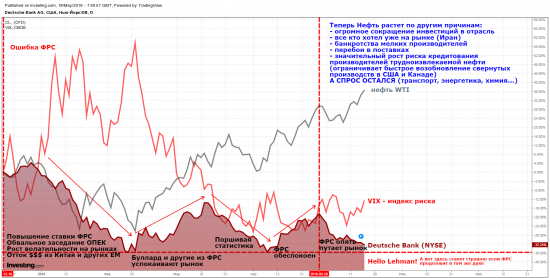
- bitcoin
- brent
- eurusd
- forex
- gbpusd
- gold
- imoex
- ipo
- nasdaq
- nyse
- rts
- s&p500
- si
- usdrub
- wti
- акции
- алготрейдинг
- алроса
- аналитика
- аэрофлот
- банки
- биржа
- биткоин
- брокеры
- валюта
- вдо
- волновой анализ
- волны эллиотта
- вопрос
- втб
- газ
- газпром
- гмк норникель
- дивиденды
- доллар
- доллар рубль
- евро
- золото
- инвестиции
- индекс мб
- инфляция
- китай
- кризис
- криптовалюта
- лидеры роста и падения ммвб
- лукойл
- магнит
- ммвб
- мобильный пост
- мосбиржа
- московская биржа
- мтс
- нефть
- новатэк
- новости
- обзор рынка
- облигации
- опрос
- опционы
- отчеты мсфо
- офз
- оффтоп
- прогноз
- прогноз по акциям
- раскрытие информации
- ри
- роснефть
- россия
- ртс
- рубль
- рынки
- рынок
- санкции
- сбер
- сбербанк
- северсталь
- си
- сигналы
- смартлаб
- сущфакты
- сша
- технический анализ
- торговля
- торговые роботы
- торговые сигналы
- трейдер
- трейдинг
- украина
- фондовый рынок
- форекс
- фрс
- фьючерс
- фьючерс mix
- фьючерс ртс
- фьючерсы
- цб
- цб рф
- экономика
- юмор
- яндекс


















 Новости тг-канал
Новости тг-канал
